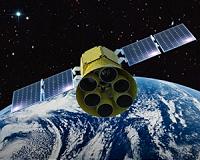 |
Paris, France (SPX) Jan 13, 2010 Using interferometry, an international team led by an astronomer of Paris Observatory (LESIA) obtained an unprecedented image of the surface of the red supergiant Betelgeuse, in the constellation of Orion. The image reveals the presence of two giant bright spots, whose size is equivalent to the Earth-Sun distance: they cover a large fraction of the surface. It is a first strong and direct indication of the presence of the convection phenomenon, transport of heat by moving matter, in a star other than the Sun. This result allows us to better understand the structure and the evolution of supergiants. Betelgeuse is a red supergiant located in the constellation of Orion. This star is quite different from our Sun: 600 times larger in dimension, it radiates approximately 100,000 times more energy. But following the Sun, this type of object also reveals a surface with bright and dark spots, i.e., hotter and colder spots. These structures would be mainly due to the phenomenon of convection, i.e., the transport of heat by matter currents. This phenomenon is observed every day in boiling water. On the surface of the Sun, these spots are rather well-known and visible. However, it is not at all the case for other stars and in particular supergiants. The size, physical characteristics, and lifetime of these dynamical structures remain unknown. Betelgeuse is a good target for interferometry because its size and brightness make it easier to observe. Using simultaneously the three telescopes of the Infrared Optical Telescope Array (IOTA) interferometer on Mount Hopkins in Arizona (removed since then), the team partly formed by three researchers from Paris Observatory could obtain a great number of high-precision measurements. These made it possible to reconstruct an image of the star surface thanks to two algorithms. A small number of computer programs are used by the few astronomers who use astronomical interferometry to produce images. Here, two different algorithms gave the same image. One was created by Eric Thiebaut from the Astronomical Research Center of Lyon (CRAL) and the other was developed by Laurent Mugnier and Serge Meimon from ONERA. The final image reveals the star surface with unprecedented fine details. Two bright spots clearly show up next to the center of the star. Other images of less quality of Betelgeuse's surface had already been obtained in the past. They were primarily models of the surface constrained from interferometric data. Now, the researchers have a true image whose richness exceeds what is possible to imagine from a model. For the first time, one can say that two spots are present and determine the size of the largest. Perhaps this difference in dimension corresponds to different physical phenomena. The analysis of the brightness of the spots shows a variation of 500 degrees compared to the average temperature of the star (3,600 Kelvins). The largest of the two structures has a dimension equivalent to the quarter of the star diameter (or one and a half the Earth-Sun distance). This marks a clear difference with the Sun where the convection cells are much finer and reach hardly 1/20th of the solar radius (a few Earth radii). These characteristics are compatible with the idea of luminous spots produced by convection. These results constitute a first strong and direct indication of the presence of convection on the surface of a star other than the Sun. Convection could play an important role in the explanation of the mass-loss phenomenon and in the gigantic plume of gas that is expelled from Betelgeuse. The latter has been discovered by a team led by Pierre Kervella from Paris Observatory. Convection cells are potentially at the origin of the hot gas ejections. A new research field is opening. This has been made possible thanks to Paris Observatory researchers who now take advantage of their mastery in interferometry on the largest telescopes in the world: Keck I and II, Gemini, the Canada-France-Hawaii Telescope, and the European Very Large Telescope.
Share This Article With Planet Earth
Related Links Paris Observatory (LESIA) Lands Beyond Beyond - extra solar planets - news and science Life Beyond Earth
 Satellite Could Locate Hundreds Of Earth-Sized Planets
Satellite Could Locate Hundreds Of Earth-Sized PlanetsBoston MA (SPX) Jan 13, 2010 The race to find exoplanets - planets outside our solar system - continues to quicken. Last week NASA researchers announced that the agency's new space telescope, Kepler, has discovered five new exoplanets, expanding the number of known exoplanets to 422, an increase of about 25 percent in the past year alone. A satellite proposed by MIT researchers could acce ... read more |
|
| The content herein, unless otherwise known to be public domain, are Copyright 1995-2009 - SpaceDaily. AFP and UPI Wire Stories are copyright Agence France-Presse and United Press International. ESA Portal Reports are copyright European Space Agency. All NASA sourced material is public domain. Additional copyrights may apply in whole or part to other bona fide parties. Advertising does not imply endorsement,agreement or approval of any opinions, statements or information provided by SpaceDaily on any Web page published or hosted by SpaceDaily. Privacy Statement |